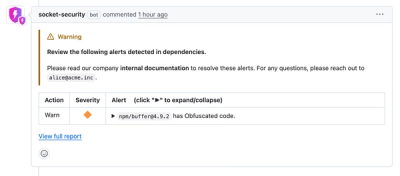
Security News
Crates.io Users Targeted by Phishing Emails
The Rust Security Response WG is warning of phishing emails from rustfoundation.dev targeting crates.io users.
A Django messaging library that features:
We try to make herald support all versions of django that django supports + all versions in between.
For python, herald supports all versions of python that the above versions of django support.
So as of herald v0.3 we support django 3.2 and 4.x+, and python 3.6, 3.7, 3.8, 3.9, and 3.10.
pip install django-heraldherald and django.contrib.sites to INSTALLED_APPS.from django.conf import settings
from django.conf.urls import url, include
urlpatterns = []
if settings.DEBUG:
urlpatterns = [
url(r'^herald/', include('herald.urls')),
] + urlpatterns
notifications.py file in any django app. This is where your notification classes will live. Add a class like this:from herald import registry
from herald.base import EmailNotification
class WelcomeEmail(EmailNotification): # extend from EmailNotification for emails
template_name = 'welcome_email' # name of template, without extension
subject = 'Welcome' # subject of email
def __init__(self, user): # optionally customize the initialization
self.context = {'user': user} # set context for the template rendering
self.to_emails = [user.email] # set list of emails to send to
@staticmethod
def get_demo_args(): # define a static method to return list of args needed to initialize class for testing
from users.models import User
return [User.objects.order_by('?')[0]]
registry.register(WelcomeEmail) # finally, register your notification class
# Alternatively, a class decorator can be used to register the notification:
@registry.register_decorator()
class WelcomeEmail(EmailNotification):
...
Create templates for rendering the email using this file structure:
templates/
herald/
text/
welcome_email.txt
html/
welcome_email.html
Test how your email looks by navigating to /herald/.
Send your email wherever you need in your code:
WelcomeEmail(user).send()
View the sent emails in django admin and even be able to resend it.
The following options can be set on the email notification class. For Example:
class WelcomeEmail(EmailNotification):
cc = ['test@example.com']
from_email: (str, default: settings.DEFAULT_FROM_EMAIL) email address of sender
subject: (str, default: ) email subject
to_emails: (List[str], default: None) list of email strings to send to
bcc: (List[str], default: None) list of email strings to send as bcc
cc: (List[str], default: None) list of email strings to send as cc
headers: (dict, default: None) extra headers to be passed along to the EmailMultiAlternatives object
reply_to: (List[str], default: None) list of email strings to send as the Reply-To emails
attachments: (list) list of attachments. See "Email Attachments" below for more info
Herald can automatically delete old notifications whenever a new notification is sent.
To enable this, set the HERALD_NOTIFICATION_RETENTION_TIME setting to a timedelta instance.
For example:
HERALD_NOTIFICATION_RETENTION_TIME = timedelta(weeks=8)
Will delete all notifications older than 8 weeks every time a new notification is sent.
The delnotifs command is useful for purging the notification history.
The default usage will delete everything from sent during today:
python manage.py delnotifs
However, you can also pass arguments for start or end dates. end is up to, but not including that date.
end is specified, delete anything sent before the end date.start is specified, delete anything sent since the start date.start and end are specified, delete anything sent in between, not including the end date.python manage.py delnotifs --start='2016-01-01' --end='2016-01-10'
If you are sending slightly different emails to a large number of people, it might take quite a while to process. By default, Django will process this all synchronously. For asynchronous support, we recommend django-celery-email. It is very straightfoward to setup and integrate: https://github.com/pmclanahan/django-celery-email
Django has built-in support for sending password reset emails. If you would like to send those emails using herald, you can use the notification class in herald.contrib.auth.
First, add herald.contrib.auth to INSTALLED_APPS (in addition to herald).
Second, use the HeraldPasswordResetForm in place of django's built in PasswordResetForm. This step is entirely dependant on your project structure, but it essentially just involves changing the form class on the password reset view in some way:
# you may simply just need to override the password reset url like so:
url(r'^password_reset/$', password_reset, name='password_reset', {'password_reset_form': HeraldPasswordResetForm}),
# of if you are using something like django-authtools:
url(r'^password_reset/$', PasswordResetView.as_view(form_class=HeraldPasswordResetForm), name='password_reset'),
# or you may have a customized version of the password reset view:
class MyPasswordResetView(FormView):
form_class = HeraldPasswordResetForm # change the form class here
# or, you may have a custom password reset form already. In that case, you will want to extend from the HeraldPasswordResetForm:
class MyPasswordResetForm(HeraldPasswordResetForm):
...
# alternatively, you could even just send the notification wherever you wish, seperate from the form:
PasswordResetEmail(some_user).send()
Third, you may want to customize the templates for the email. By default, herald will use the registration/password_reset_email.html that is provided by django for both the html and text versions of the email. But you can simply override herald/html/password_reset.html and/or herald/text/password_reset.txt to suit your needs.
If you want to disable certain notifications per user, add a record to the UserNotification table and add notifications to the disabled_notifications many to many table.
For example:
user = User.objects.get(id=user.id)
notification = Notification.objects.get(notification_class=MyNotification.get_class_path())
# disable the notification
user.usernotification.disabled_notifications.add(notification)
By default, notifications can be disabled. You can put can_disable = False in your notification class and the system will populate the database with this default. Your Notification class can also override the verbose_name by setting it in your inherited Notification class. Like this:
class MyNotification(EmailNotification):
can_disable = False
verbose_name = "My Required Notification"
To send attachments, assign a list of attachments to the attachments attribute of your EmailNotification instance, or override the get_attachments() method.
Each attachment in the list can be one of the following:
raw_data = get_pdf_data()
email.attachments = [
('Report.pdf', raw_data, 'application/pdf'),
('report.txt', 'text version of report', 'text/plain')
]
email.send()
A MIMEBase object. See the documentation for attachments under EmailMessage Objects/attachments in the Django documentation.
A django File object.
Sometimes you want to embed an image directly into the email content. Do that by using a MIMEImage assigning a content id header to a MIMEImage, like this:
email = WelcomeEmail(user)
im = get_thumbnail(image_file.name, '600x600', quality=95)
my_image = MIMEImage(im.read()) # MIMEImage inherits from MIMEBase
my_image.add_header('Content-ID', '<{}>'.format(image_file.name))
You can refer to these images in your html email templates using the Content ID (cid) like this:
<img src="cid:{{image_file.name}}" />
You would of course need to add the "image_file" to your template context in the example above. You can also accomplish this using file operations. In this example we overrode the get_attachments method of an EmailNotification.
class MyNotification(EmailNotification):
context = {'hello': 'world'}
template_name = 'welcome_email'
to_emails = ['somebody@example.com']
subject = "My email test"
def get_attachments(self):
fp = open('python.jpeg', 'rb')
img = MIMEImage(fp.read())
img.add_header('Content-ID', '<{}>'.format('python.jpeg'))
return [
img,
]
And in your template you would refer to it like this, and you would not need to add anything to the context:
<img src="cid:python.jpeg" />
Django Herald can auto convert your HTML emails to plain text. Any email without a plain text version will be auto converted if you enable this feature.
# Install html2text
pip install django-herald[html2text]
In your settings.py file:
HERALD_HTML2TEXT_ENABLED = True
You can customize the output of HTML2Text by setting a configuration dictionary. See HTML2Text Configuration for options
HERALD_HTML2TEXT_CONFIG = {
# Key / value configuration of html2text
'ignore_images': True # Ignores images in conversion
}
HERALD_RAISE_MISSING_TEMPLATES = True
By default, Herald will raise an exception if a template is missing when true (default).
# Install twilio
pip install django-herald[twilio]
You can retrieve these values on Twilio Console. Once you have retrieve the necessary ids, you can place those to your settings.py.
For reference, Twilio has some great tutorials for python. Twilio Python Tutorial
# Twilio configurations
# values taken from `twilio console`
TWILIO_ACCOUNT_SID = "your_account_sid"
TWILIO_AUTH_TOKEN = "your_auth_token"
TWILIO_DEFAULT_FROM_NUMBER = "+1234567890"
You can also attach any MIMEBase objects as regular attachments, but you must add a content-disposition header, or they will be inaccessible:
my_image.add_header('Content-Disposition', 'attachment; filename="python.jpg"')
Attachments can cause your database to become quite large, so you should be sure to run the management commands to purge the database of old messages.
python runtests.py
FAQs
Django library for separating the message content from transmission method
We found that django-herald demonstrated a healthy version release cadence and project activity because the last version was released less than a year ago. It has 4 open source maintainers collaborating on the project.
Did you know?

Socket for GitHub automatically highlights issues in each pull request and monitors the health of all your open source dependencies. Discover the contents of your packages and block harmful activity before you install or update your dependencies.

Security News
The Rust Security Response WG is warning of phishing emails from rustfoundation.dev targeting crates.io users.

Product
Socket now lets you customize pull request alert headers, helping security teams share clear guidance right in PRs to speed reviews and reduce back-and-forth.

Product
Socket's Rust support is moving to Beta: all users can scan Cargo projects and generate SBOMs, including Cargo.toml-only crates, with Rust-aware supply chain checks.